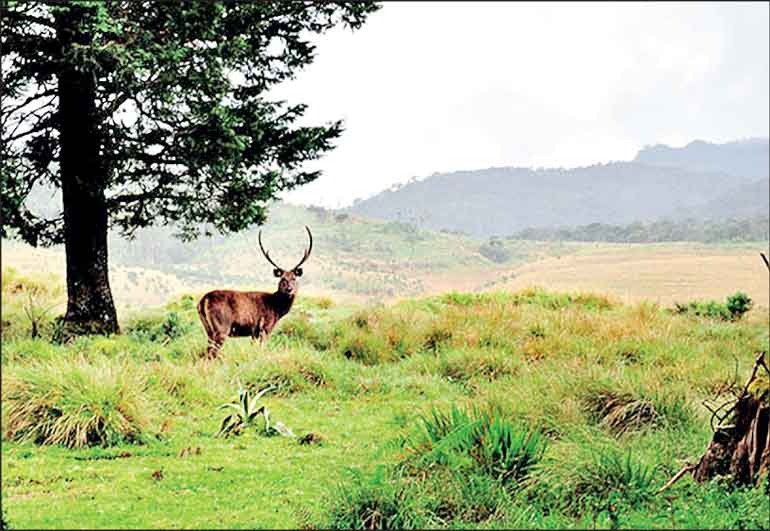Sunday Dec 07, 2025
Sunday Dec 07, 2025
Tuesday, 8 February 2022 00:10 - - {{hitsCtrl.values.hits}}

Sri Lanka as a biodiversity hotspot as well as a developing country has faced challenges in protecting its endemic fauna and flora from commercially developed countries and multinational companies
 How could you justify the fact that a person who is sitting on a gold mine, is begging for money from his neighbours? Does it sound like a familiar story? I am talking about us! Let me prove the following to you: Biodiversity of Sri Lanka has a vast potential to be transformed into a great source of income.
How could you justify the fact that a person who is sitting on a gold mine, is begging for money from his neighbours? Does it sound like a familiar story? I am talking about us! Let me prove the following to you: Biodiversity of Sri Lanka has a vast potential to be transformed into a great source of income.
Commercialisation of genetic resources is a booming business. From drugs, cosmetics, to teas and genetically modified crops to plant and animal materials, these products are ubiquitous in consumer markets. Many of these products are aggressively protected by patents that profess the products’ “innovativeness.” But these products are arguably neither new nor innovative, as their use of genetic resources has been developed based on the traditional knowledge of the natural world, often held, and carefully guarded by indigenous groups and rural farmers.
Traditional knowledge is a living body of knowledge that is created, maintained, and passed down from generation to generation within a group, often being a part of its cultural or spiritual identity. This knowledge also includes formulations used to treat human diseases. This knowledge has passed the test of time since they have been in practice for centuries.
The preservation, protection, and promotion of traditional knowledge-based innovations and practices of local communities are of particular importance to developing countries. This knowledge includes dealing with biochemicals, their nature, properties, and multifarious uses, which have the potential of adding value to the quality of normal life. Yet, these traditional knowledge holders are rarely compensated for their role in producing and safeguarding the biodiversity from which the patent-holders profit.
This leads to the topic of this article, which is biopiracy. Biopiracy means the gaining of exclusive monopoly rights over the biological material of one country by individuals, institutions or companies of other countries that ultimately leads to the denial of the rights of the country of origin. This has become the most fast spreading mafia in the world today. Biopiracy is historically associated with colonialism, where developing resource-rich countries and indigenous populations would be exploited without permission.
Biopiracy today
 The threat of biopiracy in the face of multinational companies, specifically pharmaceutical entities, brings forth the question of guarding these treasures against illegitimate exploitation. Biopiracy has emerged as a term to describe how corporations in the developed world claim ownership or otherwise take unfair advantage or free ride on the genetic resources and traditional knowledge and technology of developing countries. Biopiracy can be described as a silent disease which is hardly detectable because it is usually clandestine in nature.
The threat of biopiracy in the face of multinational companies, specifically pharmaceutical entities, brings forth the question of guarding these treasures against illegitimate exploitation. Biopiracy has emerged as a term to describe how corporations in the developed world claim ownership or otherwise take unfair advantage or free ride on the genetic resources and traditional knowledge and technology of developing countries. Biopiracy can be described as a silent disease which is hardly detectable because it is usually clandestine in nature.
Biopiracy operates through unfair application of patents to genetic resources and traditional knowledge. By patenting these substances, the companies selling them are essentially claiming them as their own intellectual property, excluding others from using, selling, and importing the material for a certain period of time.
As a result of biopiracy there are many negative effects on biodiversity such as extinction of endemic living organisms, depletion of biodiversity, and privatisation of bio treasures of the country. Furthermore, it affects the cultural identity and the traditional knowledge of the indigenous people in the country. Global intellectual property rules have resulted in biopiracy, raising serious ethical concerns of environmental justice, exploitation, and health disparities in these populations.
Biopiracy and Sri Lanka
Sri Lanka’s biodiversity is a remarkable hotspot, high proportion of species (23% of the flowering plants and 16% of the mammals) on the island are endemic (can be found only in our country). In the tropics there is a range of plant species that have been utilised by generations of our people for treatment of diseases. Sri Lanka is in the top 34 biodiversity hotspots, having the highest biodiversity per unit area of terrestrial among all Asian countries.
The recent surveys indicated that there are 1,432 medicinal herbs and plant species in Sri Lanka, and out of them, 100-200 species are endangered. It is vital to rationally utilise medicinal plants for curative purposes, paying close attention to maintenance of biodiversity.
Most multinational biotechnology companies rely on the genes of living organisms as its raw materials where they reiterate the old “Gold Rush” as new “Gene Rush” with the goal of future profits. The “Gene Rush” is the new era of biotechnology that allows scientists to extract specific genes from living organisms as raw materials. Sri Lanka has been marked with imminent danger as a target of biopiracy due to the quest for genetic resources among bio pirates. Recent developments relating to biopiracy have entered a large, alarming scale.
Sri Lanka as a biodiversity hotspot as well as a developing country has faced challenges in protecting its endemic fauna and flora from commercially developed countries and multinational companies. Transnational commercial enterprises are using intellectual property rights to patent indigenous medicinal plants, seeds, genetic resources, and traditional medicines. Sri Lanka is already a country badly affected by biopiracy, as many local species have been smuggled out of the country and patented by foreign companies.
So far, a larger number of patents have been obtained for plants, animals, and microorganisms indigenous to Sri Lanka. It is mainly the medicinal plants that are being subject to biopiracy in Sri Lanka. At present the legal provision against biopiracy in Sri Lanka doesn’t control the situation and creates room for biopiracy on the island. Most of the patents regarding Sri Lankan genetics have been obtained by Japan. Alarmingly, the patent system has evolved over the past three-four decades in such a way that companies often patent not only technical inventions, but entire natural species and their uses.
Although biopiracy has been occurring in Sri Lanka for decades, there has been a perilously low counterattack from the Government. The Sri Lankan authorities remain deaf and mute when the Sri Lankan bio-products are being smuggled out of the country and patented elsewhere notwithstanding international legal mechanisms which are available. Sri Lanka’s lack of progress in combating this issue on all fronts is noticeable. The public does not seem sufficiently informed of the value of the country’s biological assets which are being plundered.
Unfortunately, Sri Lanka is far behind in terms of implementing laws to protect us from biopiracy, documenting and patenting their endemic species compared with most Asian, South American and African countries. Some of these countries have even decided to take their existing cases of biopiracy to international court.
Ethiopia and teff
The teff dossier is a clear case of ‘biopiracy’: Ethiopia found itself discarded, prevented from using its own genetic resources teff by several European countries.
Teff is an intrinsic part of Ethiopian culture. Teff is an annual grass native to Ethiopia and Eritrea. The grain is harvested and used extensively in Ethiopian foods such as injera, stews, and porridges. Ethiopians began domesticating their native grain more than 6,000 years ago. Teff is a staple in the Ethiopian diet. The Ethiopian grain has gained increasing popularity outside of Ethiopia, in Western countries especially, as a gluten-free superfood.
However, in 2005, the Ethiopian Institute of Biodiversity and Conservation partnered up with the Dutch company Health and Performance Food International (HPFI) to market one of Ethiopia’s most valuable staples, the teff grain as a cosmopolitan ‘superfood’.
Jans Roosjen, the owner of Dutch company Ancientgrain, embarked on creating an access and benefit-sharing agreement on teff genetic resources with the Ethiopian government. It began as a positive relationship that promised Ethiopia the ability to benefit from intellectual property rights and access to international markets for teff-based products.
Yet, the success of the grain never materialised and HPFI went bankrupt in 2009. The agreement with Ethiopia no longer existed and the country only managed to get € 4,000 in profits over the five years of cooperation.
However, the relationship took a turn when the Dutch company filed for European patents in 2003 without involving Ethiopia. The company claimed patents over the storing and processing of teff grain – all of which is traditional knowledge of Ethiopian farmers. The teff patent was granted by the European Patent Office (EPO) in 2007 and filed under Jans Roosjen.
The patents had led to outrage in Ethiopia, where teff is widely considered to be a part of the national cultural heritage. The teff patent excluded all other parties, including Ethiopia, from marketing and exporting teff to countries where the patent is granted. Additionally, the Ethiopian government had trouble claiming its benefits under the Teff Agreement because of the Dutch company’s decisions to transfer assets between companies and claim bankruptcy.
Ethiopia realised that they had gotten themselves into a bad deal, since then they have been fighting to reclaim ownership over their traditional grain. The Ethiopian government has vowed to fight against this patent by all legal and diplomatic means. Following court cases, the patent was annulled in 2018 in the Netherlands. This goes to show the many loopholes and forms of biodiversity patenting. Ethiopia’s struggle to reclaim its rights to teff is yet another portrayal of the ongoing battles Indigenous peoples face in having their inherent rights recognised and respected.
Conclusion
There are several useful methods for controlling the biopiracy. First of all, creating the awareness among governmental and non-governmental institutions, as well as the public, is crucial in combating biopiracy.
In addition, encouraging and facilitating the local researchers and productions, providing equipment, and training the personnel in subject fields, cost-effective technologies and user-friendly agreements like Private-Public-People partnership are also useful in controlling the biopiracy. Similarly, developing a proper monitoring system in collections that have taken place as well as at the export points are also very important. Furthermore, as is vividly demonstrated by the Ethiopian case, proper legal mechanism for access and benefit sharing is of utmost importance.
Strengthening the legislation and imposing severe penalties on offenders are very practical solutions. When there is absence of those, collaborative projects on strong legal agreements may be encouraged. Arbitration is an important tool for settling international disputes over intellectual property. Countries with higher economic interests tend to apply this tool more frequently. It also has a higher cost that cannot be ignored.
Several initiatives were established by academic institutions, industries, and international organisations to abolish adulteration and biopiracy including bioprospecting protocols. Unfortunately, the established systems are not properly followed by the developing countries due to their unaffordability of technical cost and policies. Hence, there is still a lot more to be done to combat biopiracy.
(The author currently holds the position of Director EMEA at a Dutch Cooperate Finance company. Previously he was a lecturer at Peoples’ Friendship University of Russia and Senior Researcher at Van Hall Larenstein University, The Netherlands.)